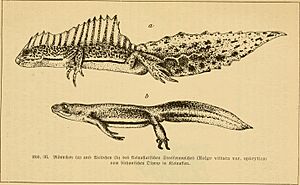Southern banded newt facts for kids
Quick facts for kids Southern banded newt |
|
|---|---|
 |
|
| Conservation status | |
| Scientific classification | |
| Genus: |
Ommatotriton
|
| Species: |
vittatus
|
| Synonyms | |
|
Triturus ophzticus Berthold, 1846 |
|
The southern banded newt (Ommatotriton vittatus) is a fascinating type of salamander. It belongs to the Salamandridae family. You can find these newts in several countries across the Middle East. These include Armenia, Iraq, Israel, Jordan, Lebanon, Syria, and Turkey.
There are two main kinds, or subspecies, of the southern banded newt. One is called O. vittatus vittatus, found in Turkey, Syria, and Israel. The other is O. vittatus ciliensis, which lives only in Turkey.
Southern banded newts are medium-sized creatures. They usually grow to be about 9 to 11 centimeters long. Females are often a bit smaller than males. They also weigh less, but both sexes are generally healthy and well-fed.
Where the Southern Banded Newt Lives
Southern banded newts live in many different watery places. You can find them in temperate forests and grasslands. They like rivers, ponds, and even canals. Sometimes, they are found in water inside caves. They can also live in water on farms and in gardens.
These newts prefer water that is not too cold or too warm. The water they live in is usually between 8.7 and 14.6 degrees Celsius. They also like water that is slightly alkaline. This means the water has a pH level between 7.5 and 8.
They often live in higher places, usually above 1500 meters. These higher areas tend to have cooler temperatures. When the weather gets very cold, below 3.9 degrees Celsius, they go into a deep sleep called hibernation. If the weather is very hot and dry, they will also rest in a similar state called aestivation.
Life Cycle and Reproduction
The southern banded newt's breeding season starts in early spring and lasts until early summer. This is usually from February to June. During this time, they move into shallow water that flows slowly. They also like water that has lots of plants. When it's not breeding season, they live in wooded areas or places with loose stones near water.
During the breeding season, male newts change their appearance. They grow large crests on their backs. Their colors also become much brighter. They do this to attract females. Males also perform special dances. They use their tails and crests to impress the females.
Male newts can be quite aggressive and protective of their space. They will defend their territory from other males. They do this by biting and chasing them away. Each male tries to keep a small area of open space, about a few tens of centimeters to 0.8 meters, for himself.
Female newts are fertilized internally. However, the males do not directly mate with the females. Instead, the male leaves a packet of sperm, called a spermatophore, for the female to pick up. A female newt will often accept sperm packets from several different males.



